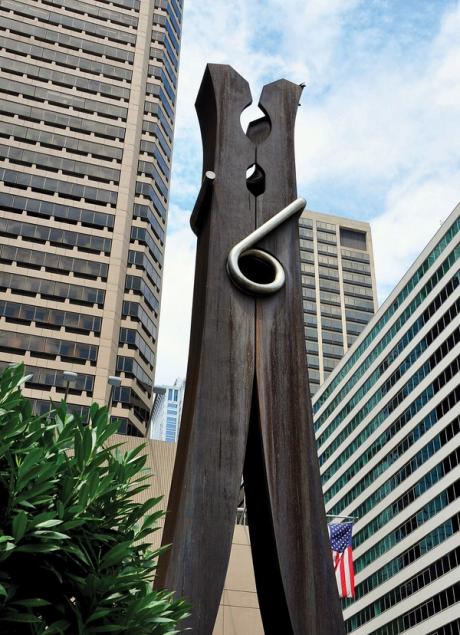
First things first: “atlas” is probably the wrong name for this book. It is organised not topographically but typologically, into sections headed “public grounds”, “public structures”, “public waters” and so on. A 21st-century art-loving Phileas Fogg would be better advised to use the “Attractions” filter on Google Maps; his friends back at the Reform Club might track his progress on social media. But if you want to look at some mostly interesting and sporadically appealing plazas, pavilions, sculptures, murals, bridges and sundry other objects produced around the world since 1960, while also having a fairly gentle think about the conditions that gave rise to them and the tensions that inflect on how we look at them, you could do a lot worse.
Certainly, this book is a sumptuous creature, elegantly crafted and lucidly written by Andrew Wassermann, the former co-chair of Public Art Dialogue, by no means uninformative and somehow very much of the moment. Its claim to a worldwide remit means that plenty of material from global-majority cultures is considered, which lends a sense of fairness, enhances the variety of material on show and ensures a certain amount of political crunch. There seems, though, to be a marked preference for the mainstream over the awkward—for projects whose aim is the jollification of a given space rather than any kind of real provocation to those who inhabit it. (Admittedly, a few projects, notably the voluptuous 2018 light piece Sparkling Pond, Bold-Coloured Groove and Tender Fire (Please walk in and let the colours caress you) by Pipilotti Rist in Sydney, do both, but they stand out as exceptions.)
Anything that ruffles powerful feathers is liable to find itself struck down and sold off for scrap before too long
Partly this comes with the territory, as in the case of Rachel Whiteread’s House (1993) in London, Jennifer Allora and Guillermo’s Chalk in Lima (2002) and Richard Serra’s Tilted Arc (1981) in New York. Anything that ruffles powerful feathers is liable to find itself struck down and sold off for scrap before too long. But there is a lot of artwashing on show here: projects that have clearly been at least part-funded by developers, then waved in the face of planning authorities as a wheeze to give a human face to lucrative commercial projects with dubious social consequences. The fact that such consequences may in their turn offer a measure of inspiration to artists is, to put it no higher, ironic. (Consider Banksy, surprisingly if not unwelcomely absent from these pages, who has been both a critic and a driver of gentrification in east London and elsewhere.)
Baffling omissions
Inevitably, anyone from anywhere in particular is likely to feel short-changed. Half the fun with books like these is nit-picking over the author’s selections, of course. As a British person, for example, I can quite understand why, say, Victor Pasmore’s neo-constructivist pavilion in Peterlee New Town (completed in 1969) might have been deemed too parochial for inclusion, even if it would have been an ideal vehicle for discussing a key theme in the book, namely the difficulty of creating public art (which generally has some sort of aspiration to permanence) when we are so ready to change our minds about what we mean by both “public” and “art”—and to disregard or actively dishonour our previous choices once we have abandoned them. And as a cishet/white/Oxbridge-educated male, I know better than to make too much of this. (Though I think that if I was Brazilian or Japanese, I’d have similar qualms about “my” heritage not getting a fair shake. Maybe that is what thinking globally really means.)
But as a European, I find it baffling that there is nothing on David Černý’s “tower babies” (2000) in Prague, say; or the metro stations of Naples; or Jean Dubuffet’s fabulous Tour aux figures in Issy-les-Moulineux on the edge of Paris (opened in 1988); or the shoes on the Danube at Budapest; or Mikhail Chemiakin’s skeletal sphinxes opposite the Kresty prison in St Petersburg; or any of the spectacular expressionist monuments created all over the former Communist world but especially in what was then Yugoslavia in the 1970s, any one of which would give Comb of the Wind, Eduardo Chilllida’s 1976 spectacular array of iron claws on the northern coast of Spain (which does feature), a run for its money.
Figuratively lacking
That 1960 terminus post quem means not much here could be described as figurative—though Mark Wallinger’s Ecce homo (1999) from Trafalgar Square gets an outing, and there is a useful contribution to the statues debate in the form of Joiri Minaya’s The Cloaking of the Statue of Christopher Columbus Behind the Bayfront Park Amphitheatre, Miami, Florida (2019)—and there are only a few specimens of the anguished semi-abstract sculptural creations that often popped up in front of big-ticket Brutalist buildings in days of yore. These few, though, more than some of the more noisily eloquent recent pieces in the book, allow us to see public art in terms of that most discredited of qualities, taste—and maybe ask ourselves hard questions about what happens when our tastes change—or when changes in the environment, or tech, or property prices, or political leadership, render judgements of taste moot.
• Andrew Wasserman, World Atlas of Public Art, Yale, 400pp, 341 colour & b/w illustrations, £35 (hb), published 6 August
• Keith Miller is an editor at The Telegraph and a regular contributor to the Literary Review and The Times Literary Supplement










